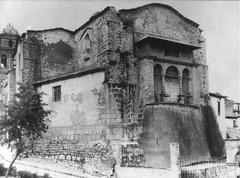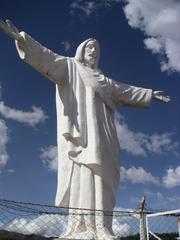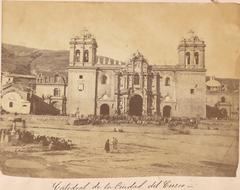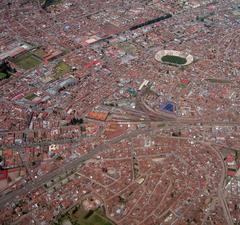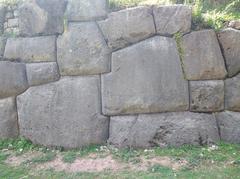Centro Qosqo de Arte Nativo, Cusco: Visiting Hours, Tickets, and Cultural Guide
Date: 14/06/2025
Introduction
The Centro Qosqo de Arte Nativo (CQAN) stands as a vibrant guardian of Andean culture in the heart of Cusco, Peru. Established in 1924, it is the country’s first folkloric institution, dedicated to preserving and promoting the rich tapestry of Andean music, dance, and oral tradition. Each evening, CQAN’s talented ensemble brings more than 50 traditional dances and over 100 melodies to life, providing both locals and visitors an immersive experience that honors the region’s indigenous heritage. Recognized as a “Patrimonio Cultural de la Nación,” CQAN is more than a venue—it’s a living archive and a cultural cornerstone, fostering intergenerational pride and artistic innovation (Centro Qosqo de Arte Nativo - Official, Peru Travel, Wikipedia).
This comprehensive guide delivers all you need to know for planning your visit, including CQAN’s history, cultural significance, visiting hours, ticketing, accessibility, performance highlights, and practical tips for an enriching experience in Cusco.
Contents
- Introduction
- Historical Overview and Mission
- Institutional Development and Recognition
- Preservation of Intangible Heritage
- Evolution of Performances and Repertoire
- Community Engagement and Educational Initiatives
- Visitor Information
- Visiting Hours
- Ticketing and Admission
- Accessibility
- Guided Tours and Photography
- Location and Nearby Attractions
- Integration with the Cusco Tourist Ticket
- Visitor Experience and Tips
- Special Events and Notable Performances
- Frequently Asked Questions (FAQ)
- Conclusion
- Sources and Further Reading
Historical Overview and Mission
Founding and Early Years
Founded amid the early 20th-century Indigenismo movement, CQAN was created in response to concerns over the loss of indigenous traditions in the face of modernization. Under the leadership of intellectuals like Luis E. Valcárcel, the center began systematically collecting, researching, and performing Andean music and dance, laying the foundation for what would become a vast repertoire representing the cultural diversity of the Cusco region and Peru as a whole (Centro Qosqo de Arte Nativo - Official).
Institutional Development and Recognition
By mid-century, CQAN had established its own theater on Avenida El Sol, inaugurated in 1949, with a capacity to seat approximately 400 guests. Through partnerships with the Peruvian Ministry of Culture and international organizations like UNESCO, the center has represented Peru on global stages and cemented its status as a leading authority on intangible cultural heritage (UNESCO Intangible Heritage, Ministerio de Cultura del Perú).
Preservation of Intangible Heritage
CQAN’s mission centers on safeguarding Peru’s rich tapestry of dances, music, and oral histories. Over the decades, the center has documented and preserved both pre-Columbian and colonial-era traditions, ensuring their transmission to future generations. The center’s archive includes extensive recordings, costumes, instruments, and ethnographic documentation, making it a vital resource for scholars and practitioners alike (Cusco Lodge Hotel, UNESCO Intangible Heritage).
Evolution of Performances and Repertoire
CQAN’s repertoire covers over 50 dances and 100 melodies, reflecting the Andean world’s diversity. Performances such as Marinera Cusqueña, Saqra, Huayno, Sikuri, and Qhapaq Qolla are staged with meticulous attention to authenticity, from choreography to the use of traditional instruments like the charango, quena, and bombo. Costumes are handwoven using natural dyes and reflect the symbolic language of each dance’s region.
To keep the tradition alive and relevant, CQAN incorporates contemporary themes and commemorates significant Peruvian events, such as Inti Raymi and Cusco’s founding anniversary. Each dance is introduced with cultural and historical context, often in both Spanish and English (Cusco Cultural Events, Qorianka Tours).
Community Engagement and Educational Initiatives
CQAN is deeply involved in community education, collaborating with schools and universities to integrate traditional music and dance into curricula. It offers workshops, lectures, and training programs for aspiring artists, ensuring the intergenerational transmission of cultural knowledge. The center also serves as a platform for young performers, many of whom go on to become cultural ambassadors (Cusco City Guide, Cosituc).
Visitor Information
Visiting Hours
- Evening Performances: Daily, typically beginning at 6:30 PM and lasting approximately 90 minutes.
- Pre-show Exhibits: Arrive at least 15–30 minutes early to enjoy lobby displays and secure seating.
- Closed: Only on major public holidays or special events (confirm dates on the official website).
Ticketing and Admission
- Standard Admission: 30–40 Peruvian soles (~$8–$11 USD) for adults.
- Discounts: Reduced rates for students, children, seniors, and Cusco residents (children under 6 often enter free; valid ID required).
- Where to Buy: Tickets are sold at the box office before the show; some authorized online platforms may be available (Centro Qosqo Tickets).
- Tourist Ticket: CQAN entry is included in the full and partial Cusco Tourist Ticket (Boleto Turístico), which grants access to multiple regional attractions.
Accessibility
- Wheelchair Access: The theater is wheelchair-friendly, with ramps and reserved seating available.
- Special Needs: Contact the venue in advance for additional accommodations.
Guided Tours and Photography
- Guided Tours: Available in various languages, often included with admission. Presenters provide insightful context about the performances, costumes, and instruments.
- Photography: Generally allowed without flash before and after shows; restrictions may apply during performances—confirm with staff upon arrival.
Location and Nearby Attractions
- Address: Avenida El Sol, 604, Cusco, Peru—just a short walk from Plaza de Armas.
- Nearby Attractions: Qorikancha (Temple of the Sun), San Blas neighborhood, Museo de Arte Popular, San Pedro Market, and Cusco Cathedral are all within walking distance. The area is well-lit and safe for evening outings (blog.viajesmachupicchu.travel).
Integration with the Cusco Tourist Ticket
The Cusco Tourist Ticket (Boleto Turístico) offers access to up to 16 attractions, including CQAN. The full ticket is valid for 10 days, with partial tickets available for shorter durations. Children under 9 enter free; discounts are available for youth with ID.
Visitor Experience and Tips
- Arrive Early: For the best seats and to browse lobby exhibits.
- Language: Most narration is in Spanish; some English translations are provided during peak seasons.
- Dress Code: Comfortable, warm clothing recommended—Cusco evenings can be cold.
- Amenities: Theater includes restrooms and a lobby for souvenirs (CDs, DVDs, crafts).
- Safety: Avenida El Sol is safe and well-patrolled, but standard precautions are advised.
- Cash: Bring cash for ticket purchase and souvenirs, as card acceptance may be limited.
Special Events and Notable Performances
CQAN hosts special performances during major festivals like Inti Raymi (June 24) and Corpus Christi, featuring expanded programs and guest artists. These events are popular and may require advance booking (Cusco Cultural Events).
Frequently Asked Questions (FAQ)
Q: What are CQAN’s visiting hours?
A: Daily performances begin at 6:30 PM and last about 90 minutes.
Q: How do I purchase tickets?
A: Buy tickets at the box office before the show, or use the Cusco Tourist Ticket.
Q: Are children allowed?
A: Yes; children are welcome, and those under six often enter free.
Q: Is the venue accessible?
A: Yes; CQAN is wheelchair-friendly and offers accommodations for visitors with disabilities.
Q: Can I take photos?
A: Photography without flash is allowed before/after performances; restrictions may apply during the show.
Q: Are guided tours available?
A: Yes; guided explanations are included, and private group tours can be arranged.
Q: What nearby sites can I visit?
A: Plaza de Armas, Qorikancha, San Blas, Museo de Arte Popular, and San Pedro Market.
Conclusion
The Centro Qosqo de Arte Nativo is a cornerstone of Peruvian cultural heritage, offering nightly performances that showcase the living traditions of the Andes. Visitors are welcomed into a world of vibrant music, dance, and costume, set within a historically rich and accessible venue. Whether you’re a cultural enthusiast or a traveler seeking an unforgettable experience, CQAN is a must-visit destination in Cusco. For the latest schedules, ticketing information, and special events, consult the official website, follow CQAN on social media, and consider integrating your visit with other historical sites in the city.
For additional resources and to enhance your cultural journey, download the Audiala app, which offers guided tours and event updates for Cusco’s top attractions.
Sources and Further Reading
- Centro Qosqo de Arte Nativo - Official
- Peru Travel - Centro Qosqo de Arte Nativo
- TripAdvisor - Centro Qosqo de Arte Nativo Reviews
- UNESCO Intangible Heritage
- Cusco Cultural Events
- Ministerio de Cultura del Perú
- Wikipedia - Centro Qosqo de Arte Nativo
- Cusco Lodge Hotel
- Qorianka Tours
- trexperienceperu.com - Cusco Tourist Ticket
- blog.viajesmachupicchu.travel
- Cosituc
- Cusco City Guide
